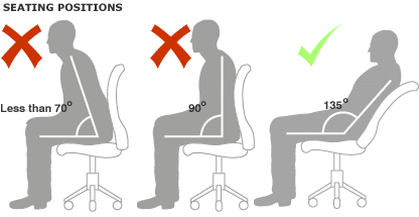 For many of us, sitting for prolonged periods of time is a daily routine. Our jobs may require sitting behind a desk or the wheel for many hours at a time. We also may spend a considerable amount of time watching TV at home or spending more time at our home computers, sitting all the while. What we don't realize is that the inside of our bodies are being affected tremendously by our sitting posture, the amount of time we sit and the exercise we may or may not get. When we move, muscles pump blood to the brain which delivers oxygen. When we sit for a long time, brain function slows down. Straining your neck by craning it forward towards a keyboard or tilting it to hold a phone can lead to misalignments of the cervical vertebrae, which in turn cause pinched nerves, high blood pressure, headaches, neck pain, shoulder pain and upper back pain. Sitting for long periods of time daily puts a person at greater risk of developing herniated disks because when a person slouches, all of their body weight is being supported by their lower back. The organs are also affected by sitting. People with the most sedentary time are twice as likely to develop cardiovascular disease because muscles burn less fat and blood flows more slowly thus allowing fatty acids to easily clog the heart. Sedentary muscles don't respond to insulin as swiftly as active muscles. So when sitting, the pancreas is alerted to produce more insulin than truly necessary. A 2011 study found a decline in insulin response after just one day of prolonged sitting. We all know the saying, "if you don't use it, you lose it." With muscle tone this is ever so true. If the muscles are not moving they degenerate, so when you sit every day for 8-10 hours a day you will start to get mushy abs, inflexible hips, and limp glutes; all of which lead to serious spinal problems because of the loss of muscle tone and muscle imbalance. As we mentioned, blood flow slows way down when sitting; this causes poor circulation, in the legs particularly, leading to swollen ankles, varicose veins, and blood clots called deep vein thrombosis. When the body is not being challenged by weight-bearing activities, the bones become fragile and brittle thus leading to osteoporosis. So what can you do to keep your day job and still prevent back problems and deterioration of the body? 1. Get adjusted regularly by a chiropractor. Adjustments to the cervical vertebrae can bring balance, relieve headaches, lower blood pressure and maintain disc health. 2. Sit in a proper position while at a desk. In the 80's and 90's chiropractors used to recommend that we sit at a 90 degree angle and bring the monitor to eye level. Although this is better than hunching over, recent research shows that this is still not optimal. The best sitting position is at 135 degrees. If you sit back a bit on your chair you can accomplish this easily. In this manner, you weight is distributed more evenly throughout the spine. The back support of the chair takes some of the weight. Watch the video below for a demo. 3. Get regular spurts of exercise while on the job. Go for a short walk, try some yoga poses at your desk, sit on an exercise ball for part of your day instead of a chair. 4. Stretch your hip flexors by doing a few lunges a day. 2-3 minutes on each side. 5. If you are not already, get 30 minutes of cardio exercise 5-6 times a week. Call us to schedule an appointment to get posture and stretch coaching by our posture expert. Click the Like button below
0 Comments
Leave a Reply. |
New Patient SpecialArchives
July 2024
Categories |
 RSS Feed
RSS Feed
